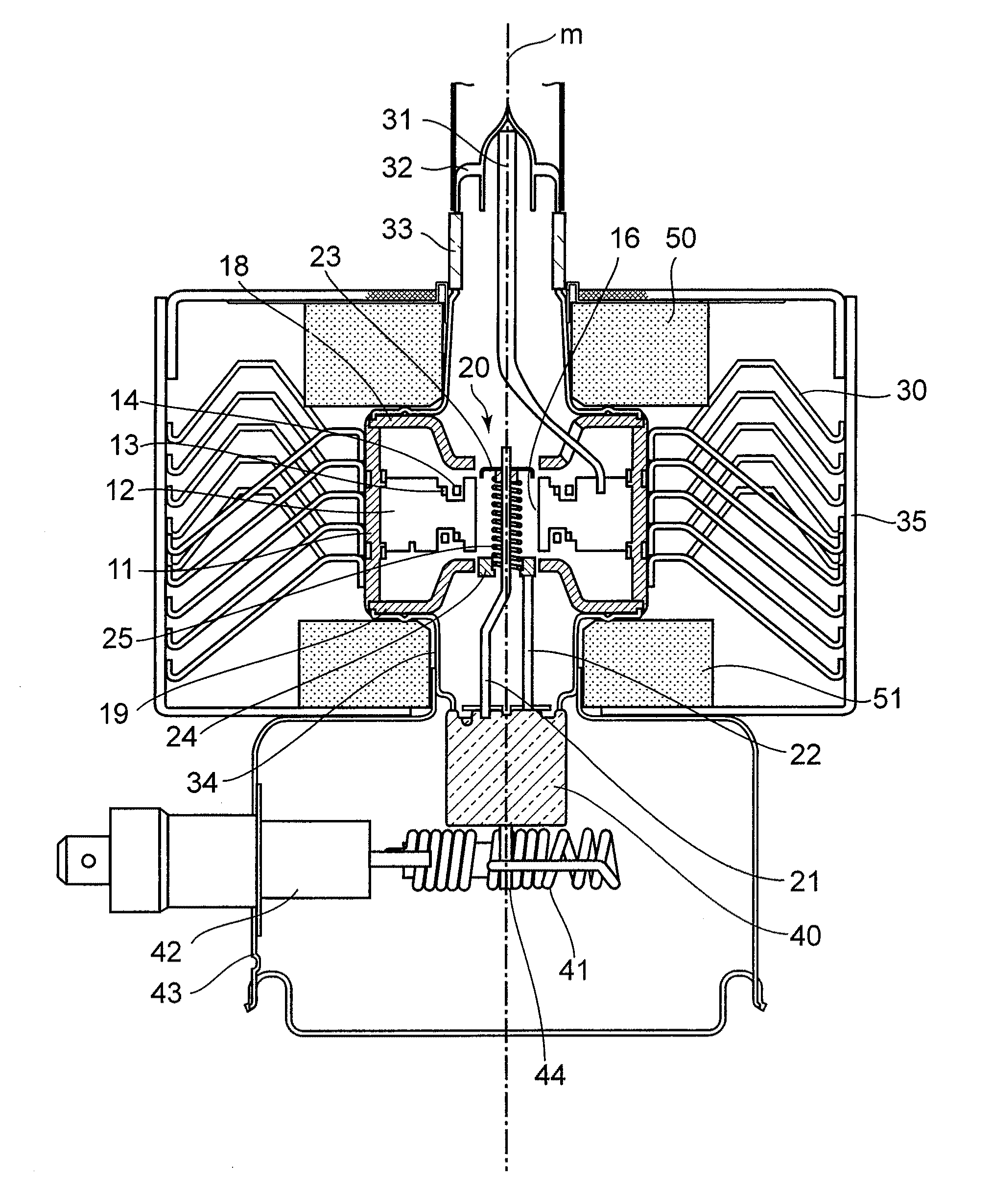Brazing material, electron tubes, magnetron and method for brazing
a technology of electron tubes and brazing materials, applied in the direction of transit-tube cathodes, manufacturing tools, solventing apparatus, etc., can solve problems such as difficulty in melting, and achieve the effects of low cost, high melting point metal, and resource saving
- Summary
- Abstract
- Description
- Claims
- Application Information
AI Technical Summary
Benefits of technology
Problems solved by technology
Method used
Image
Examples
example 1
[0054]Powders of C, B and Mo are blended and mixed together so as to be the blending of 3 wt % of C—3 wt % of B—remainder of Mo for the eutectic reaction, and formed in a disc like sintered metal part under the following condition. This sintered part 27 is set on the disc-like portion of the bottom end hat as shown in FIG. 2B, and then heated by high frequency heating under condition of coming into contact with the cathode filament. By controlling the heating temperature to be 2050° C. that is lower than the melting point of B, i.e. 2092° C., each element was melted without evaporation, so that brazing could be carried out.
[0055]grain size of C: 4 to 5 μm
[0056]grain size of B: 4 to 5 μm
[0057]grain size of Mo: 3 to 6 μm
[0058]sintered temperature: 1200° C.
example 2
[0059]Powders of C, B and Mo with the following grain sizes are blended and mixed together so as to be the blending of 1 wt % of C—1 wt % of B—remainder of Mo for the eutectic reaction, and formed in a paste with a binder. As shown in FIG. 2B, the paste-like brazing material 26 is laid on the boss 23a of the top end hat by a dispenser and dried. As a consequence of melting the above at 2050° C. by high frequency heating, brazing could be performed without evaporation of the elements.
[0060]C (1 wt %), grain size: 4 to 5 μm
[0061]B (1 wt %), grain size: 4 to 5 μm
[0062]Mo (remainder), grain size: 3 to 6 μm
example 3
[0063]Changing the mixing ratio of C, B and Mo as follows in the example 2, they are blended and mixed together, then formed in a paste with a binder. As shown in FIG. 2B, the paste-like brazing material 26 is laid on the boss 23a of the top end hat by a dispenser and dried. As a consequence of melting the above at 2050° C. by high frequency heating, brazing could be performed without evaporation of the elements.
[0064]C (2 wt %), grain size: 4 to 5 μm
[0065]B (2 wt %), grain size: 4 to 5 μm
[0066]Mo (remainder), grain size: 3 to 6 μm
[0067]Although the present invention was explained by the examples mentioned above, brazing process is not restricted to the above-mentioned explanation. For instance, respective element powders can be mixed and melted together in advance and formed in an eutectic alloy in manufacturing of the brazing material, and thereafter, they can be again crashed into powder in order to become a paste or formed in a brazing material part suitable for a brazing shape ...
PUM
| Property | Measurement | Unit |
|---|---|---|
| melting point | aaaaa | aaaaa |
| melting point | aaaaa | aaaaa |
| melting point | aaaaa | aaaaa |
Abstract
Description
Claims
Application Information
 Login to View More
Login to View More - R&D
- Intellectual Property
- Life Sciences
- Materials
- Tech Scout
- Unparalleled Data Quality
- Higher Quality Content
- 60% Fewer Hallucinations
Browse by: Latest US Patents, China's latest patents, Technical Efficacy Thesaurus, Application Domain, Technology Topic, Popular Technical Reports.
© 2025 PatSnap. All rights reserved.Legal|Privacy policy|Modern Slavery Act Transparency Statement|Sitemap|About US| Contact US: help@patsnap.com



